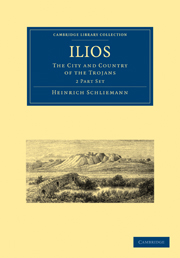Book contents
- Frontmatter
- Contents
- MAPS AND PLANS
- DIAGRAM
- COMPARATIVE TABLE OF FRENCH AND ENGLISH MEASURES, EXACT AND APPROXIMATE
- PREFACE
- INTRODUCTION.—AUTOBIOGRAPHY OF THE AUTHOR, AND NARRATIVE OF HIS WORK AT TROY
- CHAPTER I THE COUNTRY OF THE TROJANS (οἱ Τρῶες)
- CHAPTER II ETHNOGRAPHY OF THE TROJANS: THEIR SEVERAL DOMINIONS IN THE TROAD: TOPOGRAPHY OF TROY
- CHAPTER III THE HISTORY OF TROY
- CHAPTER IV THE TRUE SITE OF HOMER'S ILIUM
- CHAPTER V THE FIRST PRE-HISTORIC CITY ON THE HILL OF HISSARLIK
- CHAPTER VI THE SECOND PRE-HISTORIC CITY ON THE SITE OF TROY
- CHAPTER VII THE THIRD, THE BURNT CITY, Page 305 to 357
- THE THIRD, THE BURNT CITY, Page 358 to 413
- THE THIRD, THE BURNT CITY, Page 414 to 465
- THE THIRD, THE BURNT CITY, Page 466 to 517
- CHAPTER VIII THE FOURTH PRE-HISTORIC CITY ON THE SITE OF TROY
- CHAPTER IX THE FIFTH PRE-HISTORIC CITY OF TROY
- CHAPTER X THE SIXTH CITY, MOST PROBABLY A LYDIAN SETTLEMENT
- CHAPTER XI THE SEVENTH CITY: THE GREEK ILIUM; OR NOVUM ILIUM
- CHAPTER XII THE CONICAL MOUNDS IN THE TROAD CALLED THE HEROIC TUMULI
- APPENDIX I TROY AND HISSARLIK
- APPENDIX II ON THE RELATION OF NOVUM ILIUM TO THE ILIOS OF HOMER
- APPENDIX III THE INSCRIPTIONS FOUND AT HISSARLIK
- APPENDIX IV THYMBRA, HANAÏ TEPEH
- APPENDIX V MEDICAL PRACTICE IN THE TROAD IN 1869
- APPENDIX VI CATALOGUE OF THE PLANTS HITHERTO KNOWN OF THE TROAD, COMPILED ACCORDING TO THE COLLECTIONS OF PROFESSOR RUDOLF VIRCHOW AND DR. JULIUS SCHMIDT, AND FROM THE LITERARY SOURCES BY PROFESSOR PAUL ASCHERSON OF BERLIN, PROFESSOR THEODOR VON HELDREICH OF ATHENS, AND DOCTOR F. KURTZ OF BERLIN
- APPENDIX VII ON THE LOST ART OF HARDENING COPPER
- APPENDIX VIII ON HERA BOÖPIS
- APPENDIX IX TROY AND EGYPT
- INDEX
- Plate section
CHAPTER VIII - THE FOURTH PRE-HISTORIC CITY ON THE SITE OF TROY
Published online by Cambridge University Press: 05 August 2011
- Frontmatter
- Contents
- MAPS AND PLANS
- DIAGRAM
- COMPARATIVE TABLE OF FRENCH AND ENGLISH MEASURES, EXACT AND APPROXIMATE
- PREFACE
- INTRODUCTION.—AUTOBIOGRAPHY OF THE AUTHOR, AND NARRATIVE OF HIS WORK AT TROY
- CHAPTER I THE COUNTRY OF THE TROJANS (οἱ Τρῶες)
- CHAPTER II ETHNOGRAPHY OF THE TROJANS: THEIR SEVERAL DOMINIONS IN THE TROAD: TOPOGRAPHY OF TROY
- CHAPTER III THE HISTORY OF TROY
- CHAPTER IV THE TRUE SITE OF HOMER'S ILIUM
- CHAPTER V THE FIRST PRE-HISTORIC CITY ON THE HILL OF HISSARLIK
- CHAPTER VI THE SECOND PRE-HISTORIC CITY ON THE SITE OF TROY
- CHAPTER VII THE THIRD, THE BURNT CITY, Page 305 to 357
- THE THIRD, THE BURNT CITY, Page 358 to 413
- THE THIRD, THE BURNT CITY, Page 414 to 465
- THE THIRD, THE BURNT CITY, Page 466 to 517
- CHAPTER VIII THE FOURTH PRE-HISTORIC CITY ON THE SITE OF TROY
- CHAPTER IX THE FIFTH PRE-HISTORIC CITY OF TROY
- CHAPTER X THE SIXTH CITY, MOST PROBABLY A LYDIAN SETTLEMENT
- CHAPTER XI THE SEVENTH CITY: THE GREEK ILIUM; OR NOVUM ILIUM
- CHAPTER XII THE CONICAL MOUNDS IN THE TROAD CALLED THE HEROIC TUMULI
- APPENDIX I TROY AND HISSARLIK
- APPENDIX II ON THE RELATION OF NOVUM ILIUM TO THE ILIOS OF HOMER
- APPENDIX III THE INSCRIPTIONS FOUND AT HISSARLIK
- APPENDIX IV THYMBRA, HANAÏ TEPEH
- APPENDIX V MEDICAL PRACTICE IN THE TROAD IN 1869
- APPENDIX VI CATALOGUE OF THE PLANTS HITHERTO KNOWN OF THE TROAD, COMPILED ACCORDING TO THE COLLECTIONS OF PROFESSOR RUDOLF VIRCHOW AND DR. JULIUS SCHMIDT, AND FROM THE LITERARY SOURCES BY PROFESSOR PAUL ASCHERSON OF BERLIN, PROFESSOR THEODOR VON HELDREICH OF ATHENS, AND DOCTOR F. KURTZ OF BERLIN
- APPENDIX VII ON THE LOST ART OF HARDENING COPPER
- APPENDIX VIII ON HERA BOÖPIS
- APPENDIX IX TROY AND EGYPT
- INDEX
- Plate section
Summary
As we have seen in the preceding pages, the inhabitants of Novum Ilium held, according to an ancient legend, that Troy, the city of Priam, had not been entirely destroyed by the united Greek army under Agamemnon, and that it had never ceased to be inhabited. This legend is certainly confirmed by Homer, who, when Aeneas was on the point of being killed by Achilles in single combat, makes Poseidon say: “It is fated that Aeneas should be saved, in order that the race and the name of Dardanus may not utterly disappear—Dardanus, whom Zeus loved most of all the sons he begat of mortal women; because the race of Priam has now become odious to the son of Kronos: now, therefore, shall the mighty Aeneas reign over the Trojans, and the sons of his sons hereafter to he born.”
This legend has apparently been also confirmed by the criticism of my pickaæe and spade, for—as visitors can easily convince themselves with their own eyes—the south-eastern corner of the Third, the brick city, has not been destroyed by the conflagration. I must further say that this legend is also confirmed by the relies I have discovered, for—as the reader will see in the succeeding pages—we find among the successors of the burnt city the very same singular idols; the very same primitive bronze battle-axes; the very same terra-cotta vases, with or without tripod feet; the very same double-handled goblets (δέπα ἀμϕικύπελλα); the very same battle-axes of jade, porphyry, and diorite; the same rude stone hammers and saddle-querns of trachyte; the same immense mass of whorls or balls of terracotta with symbolical signs.
- Type
- Chapter
- Information
- IliosThe City and Country of the Trojans, pp. 518 - 572Publisher: Cambridge University PressPrint publication year: 2010First published in: 1880

